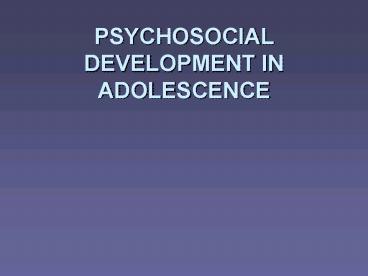PSYCHOSOCIAL DEVELOPMENT IN ADOLESCENCE - PowerPoint PPT Presentation
1 / 13
Title:
PSYCHOSOCIAL DEVELOPMENT IN ADOLESCENCE
Description:
Devotedly interested in their children's behavior, but seldom make rules ... Homosexual Behavior. Psychoanalytic Theory. Learning Theory. Biopsychosocial Theory ... – PowerPoint PPT presentation
Number of Views:804
Avg rating:3.0/5.0
Title: PSYCHOSOCIAL DEVELOPMENT IN ADOLESCENCE
1
PSYCHOSOCIAL DEVELOPMENT IN ADOLESCENCE
2
Changing American Families and Their Roles in
American Life
- The Loss of Functions Now Performed by Society
- Economic-productive
- Educational
- Religious
- Recreational
- Medical
3
Changing American Families and Their Roles in
American Life
- The Effects of Divorce
- Economic stress
- Psychological stress
- Discipline problems
4
Changing American Families and Their Roles in
American Life
- The Nurturing Parent
- Devotedly interested in their childrens
behavior, but seldom make rules to govern it - Expect their children to make personal decisions
based in instilled values
5
Peer Relations
- Developmental Patterns of Peer Groups
- 3 parenting styles of control
- Support
- Behavioral control
- Psychological control
6
Peer Relations
- Developmental Patterns of Peer Groups
- 2 behavioral patterns
- Externalization
- Internalization
7
Peer Relations
- 6 Functions of Peer Groups
- 1. Control aggressive impulses
- 2. Obtain emotional and social support
- and become more independent
- 3. Improve social skills
8
Peer Relations
- 6 Functions of Peer Groups
- 4. Develop attitudes toward sexuality
- and gender-role behavior
- 5. Strengthen moral judgment and
- values
- 6. Improve self-esteem
9
Sexual Behavior
- Sexual Behavior
- Girls are more likely to report initiating
physical sexual aggression - U.S. adolescents are becoming sexually active at
increasingly earlier ages
10
Sexual Behavior
- Homosexual Behavior
- Psychoanalytic Theory
- Learning Theory
- Biopsychosocial Theory
11
Sexually Transmitted Infections
- HIV/AIDS, Chlamydia, Gonorrhea, Pelvic
Inflammatory Disease, Genital Herpes, Syphilis
and Hepatitis B
12
The Teenage Parent
- Risk Factors
- Poverty
- Unsafe communities
- Single-parent households
- History of sexual abuse
- Have sexually active teenage siblings
13
Illegal Behavior
- Substance Abuse
- Excessive alcohol during teen years can impair
later brain functioning - Criminal Behavior
- Gangs offer youths the fulfillment of basic needs































